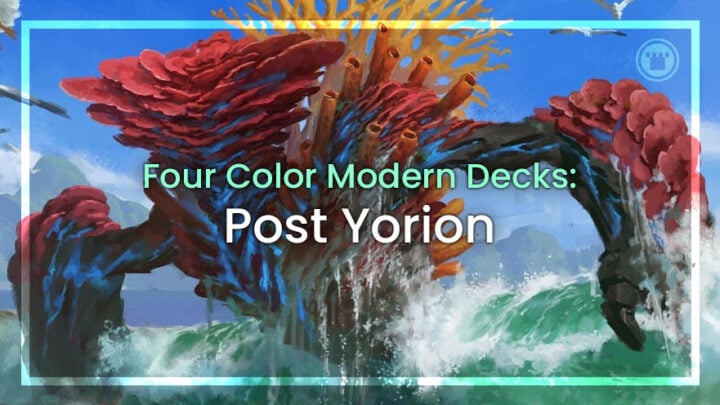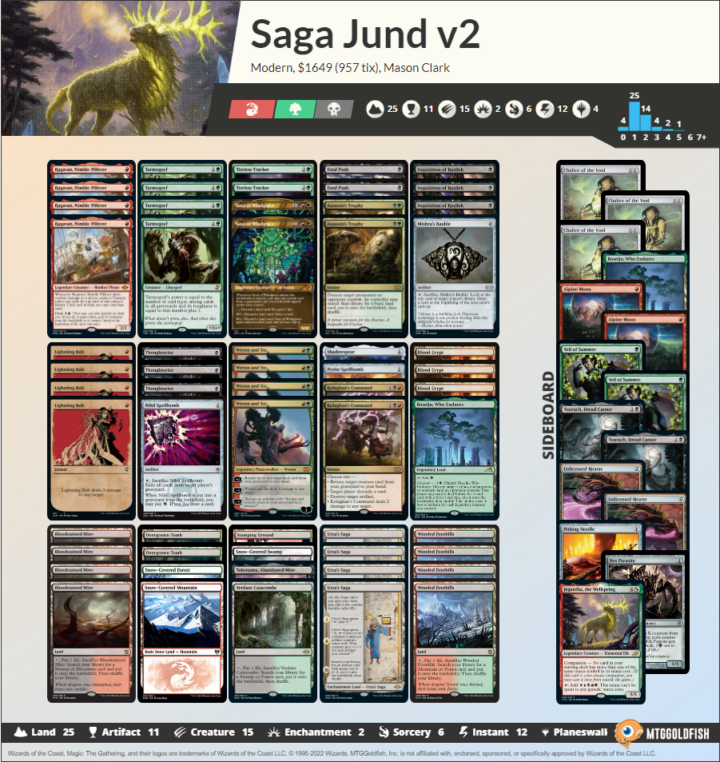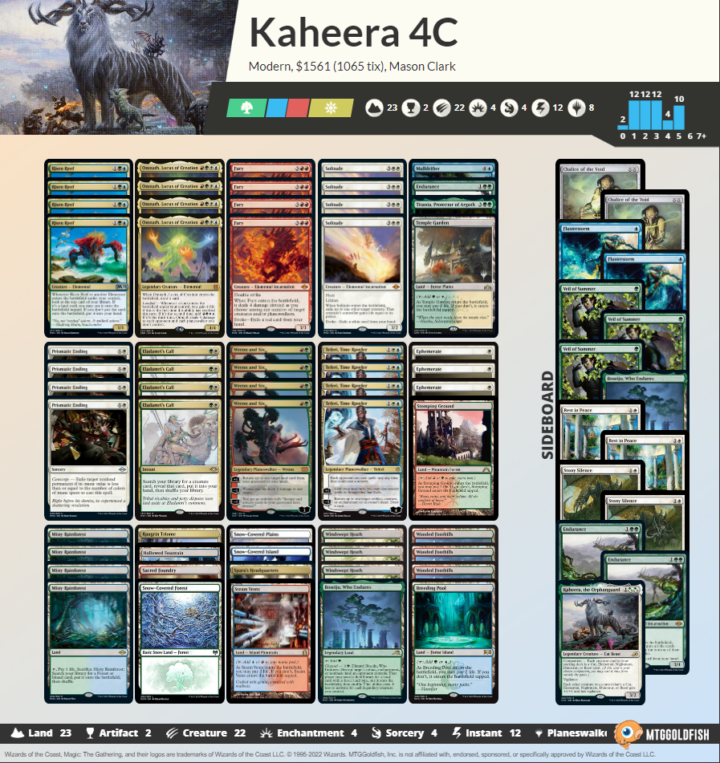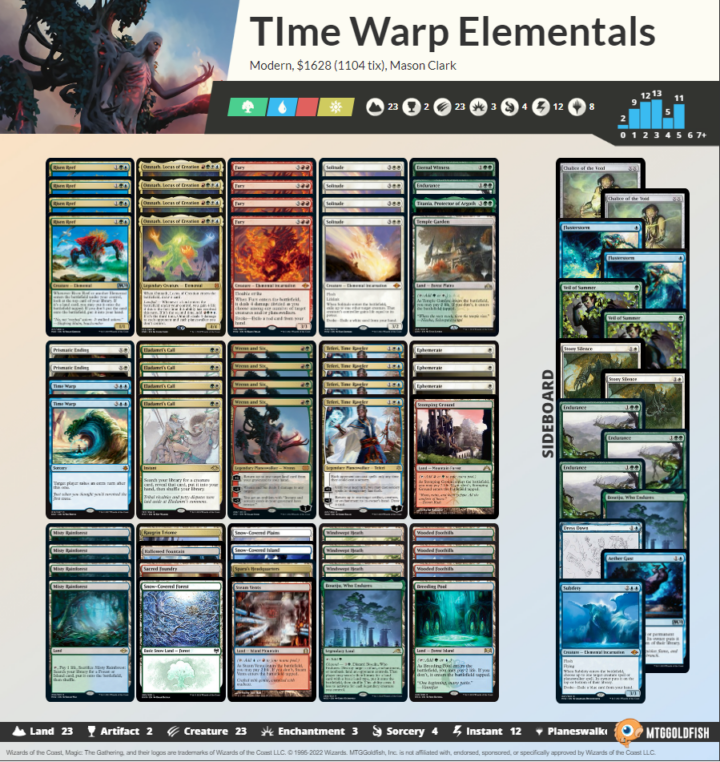This Monday, a key, Modern player suffered a ban in the latest Banned and Restricted announcement: Yorion the Sky Nomad.
This is both a huge shake up for Modern while also keeping the rules of engagement relatively the same. Often, when a big ban shakes up the format, the cards you’re trying to beat and the removal you’re trying to play through change with it. But this time, all the removal and threats from four color decks are still around — just not all in one location.
So, while Modern will be drastically different without Four Color to keep certain decks out of the metagame (like Jund), we can expect a lot of the same big players to stick around. Breach, Murktide, Rakdos Scam, Hammer, Five Color Rhino and Creativity are all decks that will probably stay in similar positions in the meta.
In the coming weeks, it will be very interesting to see how Modern shakes out. However one question has already been kicking around in the back of everyone’s mind: Do the four color decks live through the Yorion ban? If so, how would it be built? Well today we are going to tackle that exact problem.
Before going straight to the deck list, let’s cover some of the big benefits Yorion provided and see how to solve those problems now that the bird is banned. The first and biggest issue is we are no longer the deck that always has inevitability on our side.
Before, with Four Color, you could assume you could outvalue even opponents who might have a deck that goes long. You often just had more hard answers than your opponents had threats. This made beating you an uphill battle, but we no longer have that ultimate late game.
The second biggest problem is since we can’t just go forever anymore, winning becomes a problem we need to solve. A 4/5 flier was just enough to win most games, but that’s no longer an option.
Elementals
The starting place for many people trying to solve this problem is turning to elementals. This Four Color deck both came before Yorion and persisted into the sky snake’s era.
The deck looks to build up an overwhelming advantage over your opponent with cards like Risen Reef and the evoke elementals (plus Ephemerate). You’re basically just a big midrange deck.
You don’t have many plays early in the game, but once you get a Risen Reef down, you’re often starting to pull ahead. You still have plenty of removal due to the pitch elementals, so surviving is often an easy enough thing early.
You’re also a Kaheera deck, which means we get to keep companions in our life. This one comes at a low cost and is actually fairly relevant. Giving creatures like Solitude and Fury, extra power and Vigilance goes a long way in plenty of games.
So how does this deck solve the problems we mentioned? When it comes to inevitability, this list falls short outside of midrange mirrors, where it goes way over the top. And when it comes to actually winning, this deck does a fine job. Cards like Titania go a long way in closing a game out quickly.
One small deck building choice that’s probably worth covering: I don’t play any Cavern of Souls right now because I really value casting my non-elemental spells consistently. Instead, I opted to play another two fetches. I think this decision is one you need to check in on regularly, but it’s worth mentioning that this might change if your local meta is big on control or Murktide.
Either way, these elemental decks just generate so much value and are able to out grind most decks that had Yorion. Without Yorion, you should be able to go long and have a decent closing clock.
This deck is a fine candidate for solving some of the problems Modern deck builders face, but there is still some work to be done. What if we tried adding an infinite combo to the deck?
Time Warp Elementals
Like the previous deck, this one leans on Risen Reef to gain card advantage. However, this deck has one key difference: we have the Time Warp/Eternal Witness loop.
If you haven’t seen this before, the loop requires Time Warp, Eternal Witness and Ephimerate. You will cast your Time Warp to take another turn, then cast Eternal Witness to pick up the Time Warp and cast it again.
Then you cast Ephemerate on the Witness in play. It will pick up Time Warp the first time, and then just like in the old Four Color decks, your Ephemerate will be picked up after Rebound when you target Eternal Witness. You now have as many turns as you have cards in your library, and from that point, you should be able to find a win.
Now, this combo is very mana intensive to set up at first, which is why it’s best in a Risen Reef build. Reef will help you get the lands you need to enable the combo, all from hand. You can do things like cast the Eternal Witness ahead of time to enable the combo much sooner, as you can then just Ephemerate the Witness, saving three mana.
Regardless, this core shell is already a proven entity. And while Time Warp is not a card you would put in your deck if you didn’t have this combo, it actually does a good job of being a fine outside of the combo. Due to the extra resources you get with Risen Reef, the advantage of having another turn should help you pull fairly far ahead.
This deck does the best job so far of reclaiming inevitability and actually winning the game due to the combo in the deck. So, at first glance, it seems like we have solved the problems.
Still, the biggest problem facing the deck right now is that the removal is very creature heavy. We only have a few removal spells that are not the elementals, so you’re going to have a lot of games where you’re pitching and running low on resources early in order to help stabilize your game.
This will require Risen Reefs to not only live for a few turns but to really dig you out with card advantage. And, without Yorion there to flicker them for free, they could turn into a liability. But what if we tried to have a strong end game with more interaction and card advantage?
Five Color Pile

To get as close to reaching this goal as possible, I went and expanded this list into five colors for two key cards. One turns Leyline Binding into a one mana spell and the other is Soul of Windgrace.
Soul of Windgrace has overperformed in every game I’ve seen it in. Essentially, your deck is really good at flooding out, so Windgrace offers some flood protection while also excelling at triggering Omnath’s third ability to do four damage. Said third ability was a rare factor in past builds of this deck, but I could see maximizing it being very important in winning a game going forward.
This build is much more in line with what the old pile decks looked like — just strong threats with good answers. I imagine, however, that a lot of readers might question the choice of running four Fury over any Solitude. That might ultimately end up being a mistake, but my reasoning is two fold.
First, we have way more red cards than white cards, so pitch casting Fury is way more doable. The second reason is a hard cast Fury does much more damage than Solitude. After all, while Solitude stabilizes you, Fury often kills your opponent in two attacks.
The other thing you may be wondering about is Emrakul. Its inclusion was primarily for the mirrors back in the Yorrion days, however does have good uses in other matchups because it offers the highly valued inevitability. You should be able to slam Emurakul quickly in this deck, which is built to not only maximize Delirium but to consistently answer threats and present these must answer creatures.
So how does this deck do at answering the problems we raised at the beginning of this post? Well, it’s probably the worst of the three decks. It doesn’t have any crazy card advantage engines and is sort of playing like a big midrange deck.
However, when it comes to winning the game, it does win the quickest on average due to all the removal. You’re able to stick a threat and close the game out against most decks.
End Step
There is still a big problem here. Decks like blue/white control can out scale pile decks in the late game, which they couldn’t really do in the past. Walking this line will be a challenge for Four Color decks in the coming weeks and months.
Pile decks have dominated Modern now for the better part of a year. Figuring out how to build them in the coming months is something that will take time and effort as the metagame adapts. This deck needs to adjust to the other decks at the top of the format.
Still, I am sure some sort of four color pile deck will be good. The only question is which one will prevail? To find out as time goes on, make sure to follow me on Twitter.

Mason Clark is a grinder in every corner of the game who has played at the pro level and on the SCG Tour with Team Nova. Whether he’s competing in Standard, Historic or Modern, Mason plays with one goal in mind: to be a better player than he was the day before. Check out his podcast, Constructed Criticism, and catch his streams on Twitch.




